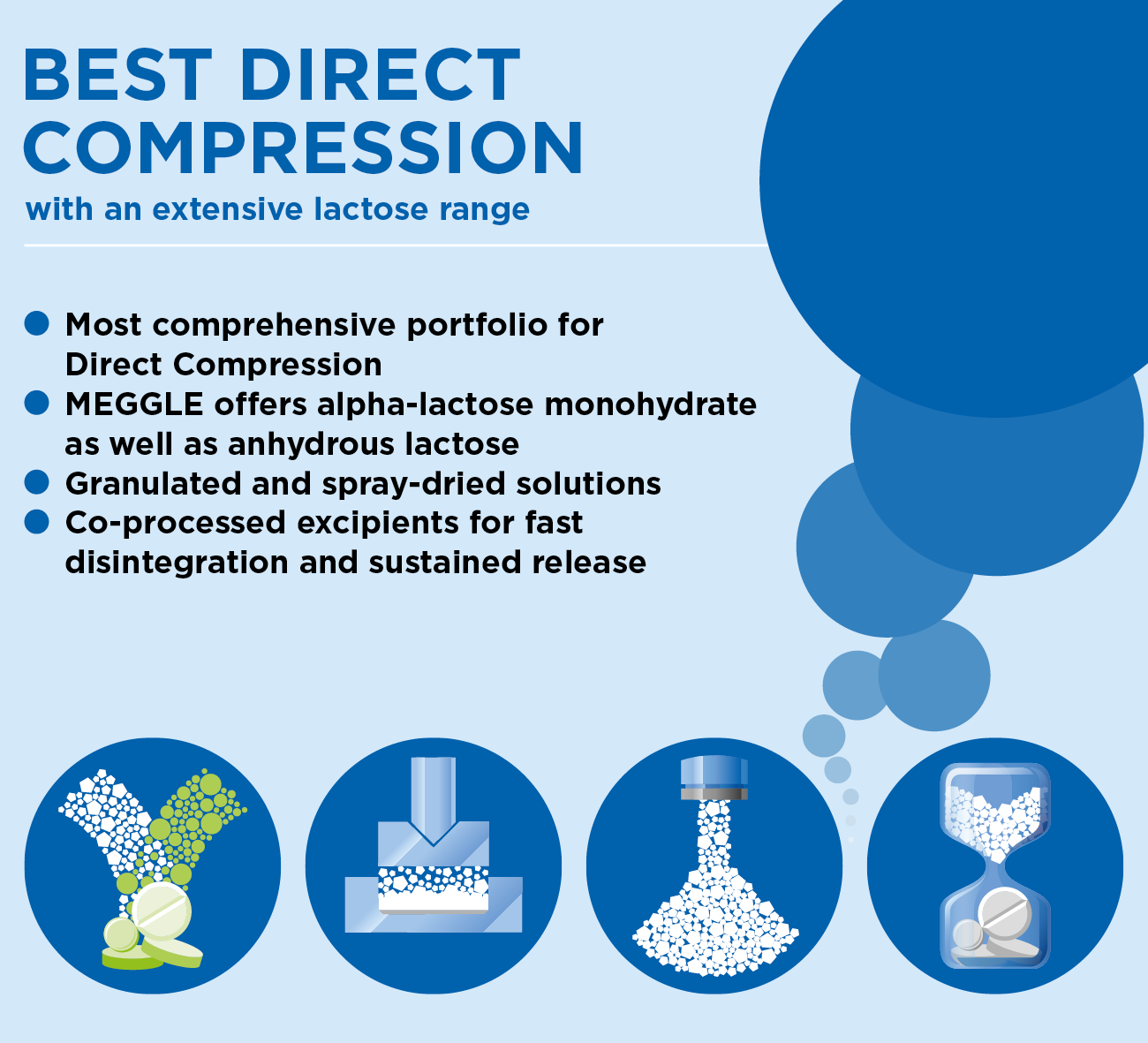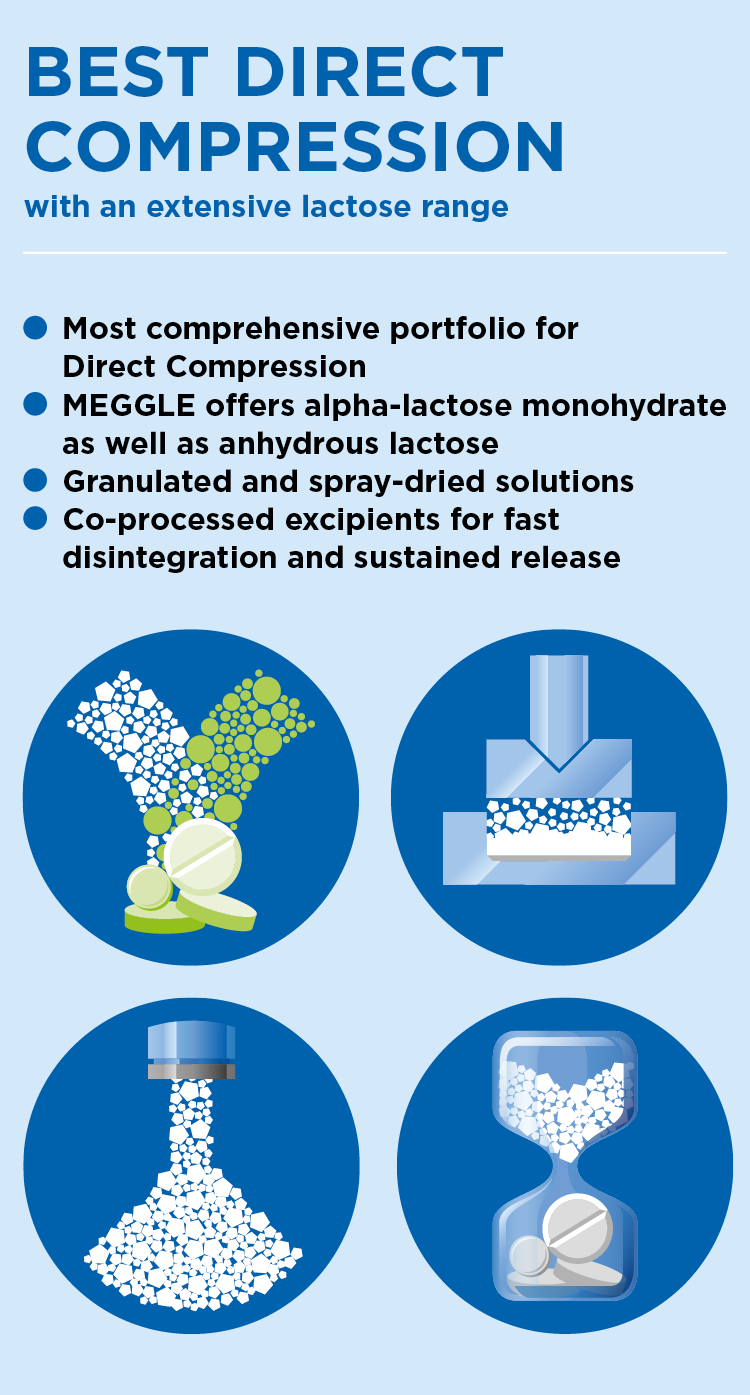Most comprehensive portfolio for Direct Compression
MEGGLE has it.
The right lactose product for Direct Compression
Since the implementation of tablets at the end of the 19th century flowability and compactibility have been rapidly identified as a powder heap’s primordial functionality.
Only a few materials show both requested properties a priori, a well-known example is NaCl (Hardman & Lilley; 1973). However, the majority of native, mono-component materials is difficult to compress, or simply not transferable into compacts. The situation gets even worse when powder blends, due to patient compliance or pharmacological necessities have to be applied. Dissimilar densities, various morphologies, unequal particle size/size distributions, charge effects or resilience behavior may initiate a demixing process, better known as segregation, when particles are allowed to move. As a consequence tablet content and mass uniformity are challenged.
Tablettose: A more than 50 years successful product group
To retain control, a wet granulation (WG) step has been introduced at early stage to ensure particle flow, beneficial component ratio and overall porosity. But this “medicine” shows its limitations, for moisture and heat may compromise for instance API stability. While elsewhere the first attempts to impact morphology and compaction behavior by spray-drying (SD) failed because of provoking a classical Maillard reaction causing product browning, MEGGLE introduced a gentle agglomeration step to convert α-lactose monohydrate monocristals into particles of superior order. This simple, but effective modification resulted in a more than 50 years successful product group, well known as Tablettose® family. In simply creating larger units, prerequisite flowability could be sufficiently enhanced being fairly good enough for ordinary, economical die filling, without compromising tablet content and mass uniformity. Consolidation by fractionation of brittle α-lactose monohydrate mono crystals contributes to the formation of adequate interparticle bonds, enabling the formation of strong compacts.
Direct Compression: MEGGLE’s broad product portfolio
Above that, thermodynamically most stable polymorph α-lactose monohydrate supports formulation stability. More sophisticated SD of a defined, purified lactose solution/suspension led to the formation of SD lactose grades mainly differing in compactibility, flowability and porosity. Formation of plastically deforming amorphous lactose contributes preferentially to compactibility; dehydration of dispersed, round droplets leads to almost complete smooth, spherical particles of similar size optimizing flowability. A broad variety of SD-lactose grades, as FlowLac® 90/100, may be seen in the market, representing the upper line in multi-functionality of lactose particles at the moment. Direct compression (DC) tablet manufacture is a popular choice because it provides the least complex, most cost effective process to produce tablets compared to other tablet manufacturing approaches. Manufacturers can blend APIs with excipients and compress, making dosage forms simple to produce.
MEGGLE’s lactose grades suitable for direct compression are available under the trade names Tablettose® 70, Tablettose® 80, Tablettose® 100, FlowLac® 90, FlowLac® 100, DuraLac® H, MicroceLac® 100, Cellactose® 80, StarLac®, RetaLac®, CombiLac®

Information / Sample request:

MEGGLE has it.
The right lactose product for Direct Compression
Since the implementation of tablets at the end of the 19th century flowability and compactibility have been rapidly identified as a powder heap’s primordial functionality.
Only a few materials show both requested properties a priori, a well-known example is NaCl (Hardman & Lilley; 1973). However, the majority of native, mono-component materials is difficult to compress, or simply not transferable into compacts. The situation gets even worse when powder blends, due to patient compliance or pharmacological necessities have to be applied. Dissimilar densities, various morphologies, unequal particle size/size distributions, charge effects or resilience behavior may initiate a demixing process, better known as segregation, when particles are allowed to move. As a consequence tablet content and mass uniformity are challenged.
Tablettose: A more than 50 years successful product group
To retain control, a wet granulation (WG) step has been introduced at early stage to ensure particle flow, beneficial component ratio and overall porosity. But this “medicine” shows its limitations, for moisture and heat may compromise for instance API stability. While elsewhere the first attempts to impact morphology and compaction behavior by spray-drying (SD) failed because of provoking a classical Maillard reaction causing product browning, MEGGLE introduced a gentle agglomeration step to convert α-lactose monohydrate monocristals into particles of superior order. This simple, but effective modification resulted in a more than 50 years successful product group, well known as Tablettose® family. In simply creating larger units, prerequisite flowability could be sufficiently enhanced being fairly good enough for ordinary, economical die filling, without compromising tablet content and mass uniformity. Consolidation by fractionation of brittle α-lactose monohydrate mono crystals contributes to the formation of adequate interparticle bonds, enabling the formation of strong compacts.
Direct Compression: MEGGLE’s broad product portfolio
Above that, thermodynamically most stable polymorph α-lactose monohydrate supports formulation stability. More sophisticated SD of a defined, purified lactose solution/suspension led to the formation of SD lactose grades mainly differing in compactibility, flowability and porosity. Formation of plastically deforming amorphous lactose contributes preferentially to compactibility; dehydration of dispersed, round droplets leads to almost complete smooth, spherical particles of similar size optimizing flowability. A broad variety of SD-lactose grades, as FlowLac® 90/100, may be seen in the market, representing the upper line in multi-functionality of lactose particles at the moment. Direct compression (DC) tablet manufacture is a popular choice because it provides the least complex, most cost effective process to produce tablets compared to other tablet manufacturing approaches. Manufacturers can blend APIs with excipients and compress, making dosage forms simple to produce.
MEGGLE’s lactose grades suitable for direct compression are available under the trade names Tablettose® 70, Tablettose® 80, Tablettose® 100, FlowLac® 90, FlowLac® 100, DuraLac® H, MicroceLac® 100, Cellactose® 80, StarLac®, RetaLac®, CombiLac®
